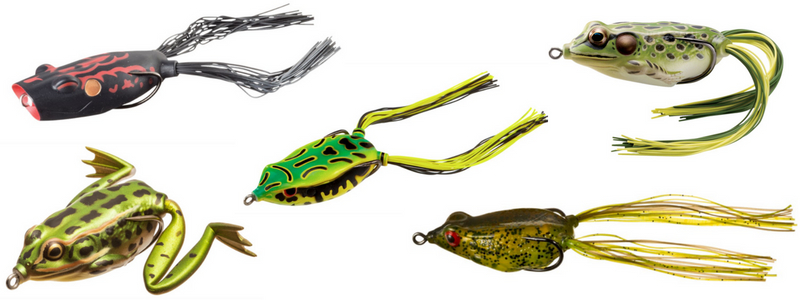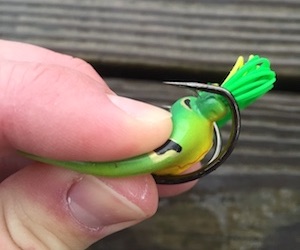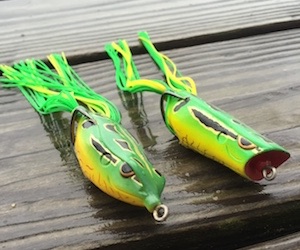
Wherever bass live, so too do multiple species of frogs, and there’s nothing bass like more than a mouthful of fresh frog. Unfortunately for these amphibians, bass like to hang out in the same areas as they do too, so the cross paths often and it typically doesn’t end well for the frog. But this is great for bass fishermen because using frog lures can provide some of the most exciting bass fishing there is!
There are many different lures out there designed to mimic a frog, from topwater popper style frogs to crankbait style frogs, but on this page we are strictly talking about what is known as frogging. This is a style of bass fishing where your throwing soft hollow-bodied frogs in to the thickest of floating vegetation.
That’s the biggest advantage of frogging, you can literally cast these lures anywhere. One of the first things noticeable about frog lures is that the hooks face upward and rest flush against the body. In addition, they float so the hooks never come close to the weeds under them. You can freely drag a frog across lily pads and other surface vegetation with no worries of getting hung up.
Contents
Types of Frog Lures
Since the most commonly fished type of frog lure is the hollow body style, that’s all we’re covering on this page. This style consists of mostly models with a pointed nose, but there are also models that have a cupped nose, like a popper lure. Besides that difference they are made up pretty similarly.
The line ties to the eyelet at the nose of the bait, which is connected to two hooks that run through the middle of the lure and pop out the rear facing up. The body of these lures is made of a very soft plastic, that is designed to collapse and expose the hook when a bass bites it. Typically they have two sets of rubber strands trailing off the back to look like kicking legs.
These lures are available in various sizes and colors. It’s a good idea to stay with natural colors like browns and greens in most waters, but especially in clear water. Most frogs have a brighter belly that’s either yellow or white, that will help them get noticed in stained or muddy water. But if the water is very murky sometimes an all white frog does the trick.
How To Fish Frog Lures
Frogging is a unique style of bass fishing, so unique that a lot of serious anglers keep a rod and reel combo designated for strictly throwing frogs. It’s mainly because of where your casting them that you require specific tackle.
Frog fishing is done mostly in thick weeds like heavily lily padded areas. Basically your taking advantage of how weedless a frog is and using it where other lures can’t go, and where bass like to be. That’s why having the right tackle is so important. If a big bass grabs your frog in the middle of a thick patch of lily pads you are going to have a hard time getting it out of there without the right tackle.
Frogging Tackle
Horsing big bass out if heavy cover is a blast, but only if the bass stays on your line, and that’s the most important aspect of frogging; your line. You need strong line like braid to be effective frog fishing. Line visibility is not important when your frogging but strength is so if your going with mono have at least twenty pound test, but braid is strongly recommended.
Your also going to need a good frogging rod with plenty of backbone to give you good leverage when wrestling bass out of the thick stuff. Combo that with a solid baitcasting reel and your good to go. Spinning reels will suffice but they don’t have nearly the same torque a baitcaster does.
Frogging Techniques
In frog fishing, all your doing is casting these lures out deep in to the middle of surface vegetation and slowly working it back across the top. The idea is to make the lure appear like a frog moving along the surface, or from lily pad to lily pad.
Lily pads, floating packed vegetation and “slop” are all great places to fish topwater hollow body lures. Slop is any type of floating algae or similar floating goopy vegetation. Bass hide out under these types of vegetation as they provide a great source of oxygenated water, shade, cover and food.
Hold your rod tip up as you retrieve to keep the lure, skating it across the top of vegetation and pausing in areas where there are breaks, holes or pockets; bass generally strike on the pause.
A really effective technique is to cast the lure on to the shore from a boat and work it into the water, giving it as much of a natural presentation as possible. This also works if you cast the frog on to a rock or floating log, then let it plop into the water. Be ready to set the hook on that initial plop.
Be sure to watch your lure the entire retrieve because strikes will often be sudden and violent. Also, resist the urge to react immediately and set the hook on topwater blowups. A lot of time bass grab the bait on the initial blow up but don’t have it all the way in their mouth, so setting the hook too quickly can result in a lost fish.
And speaking of lost fish, the biggest downside to frogging is it has a very low hookup ratio. Bass are somewhat blind in their attack on a frog, ambushing from below and through the weeds to get the lure. You’ll have some big blow ups that don’t even touch the bait, which can be disheartening. But remember you wouldn’t even be able to get to these fish without a frog so the fact that you even have a chance at them is something to smile about.




